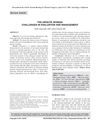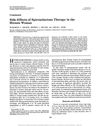TLDR Treatment improved symptoms in a woman with HAIR-AN syndrome.
The HAIR-AN Syndrome, affecting about 5% of hirsute women, was characterized by insulin resistance, elevated insulin levels, acanthosis nigricans, and hyperandrogenism. In this case report, a 21-year-old woman with secondary amenorrhea, hirsutism, and hyperpigmented skin changes was treated with oral contraceptives and spironolactone. After 9 months, she showed significant clinical and hormonal improvement.
 22 citations
,
August 2011 in “Endocrine Practice”
22 citations
,
August 2011 in “Endocrine Practice” Most hirsutism cases are due to PCOS, and treatment focuses on lowering testosterone and blocking its effects.
25 citations
,
August 1989 in “Seminars in reproductive medicine” Birth control pills are effective for treating women with too much male hormone.
 80 citations
,
January 1988 in “The Journal of clinical endocrinology and metabolism/Journal of clinical endocrinology & metabolism”
80 citations
,
January 1988 in “The Journal of clinical endocrinology and metabolism/Journal of clinical endocrinology & metabolism” Spironolactone can cause side effects like irregular bleeding, but lower doses may reduce these effects and still improve hirsutism.
53 citations
,
January 1985 in “Acta obstetricia et gynecologica Scandinavica” Low-dose oral contraceptives reduced hair growth and testosterone levels in women with polycystic ovary syndrome.

